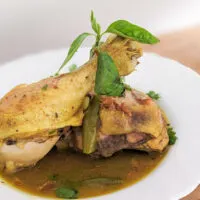Pad Ped Pla Duk Tod is the name for a Central Thai catfish curry stir fry made with crispy fried catfish and a red curry paste.
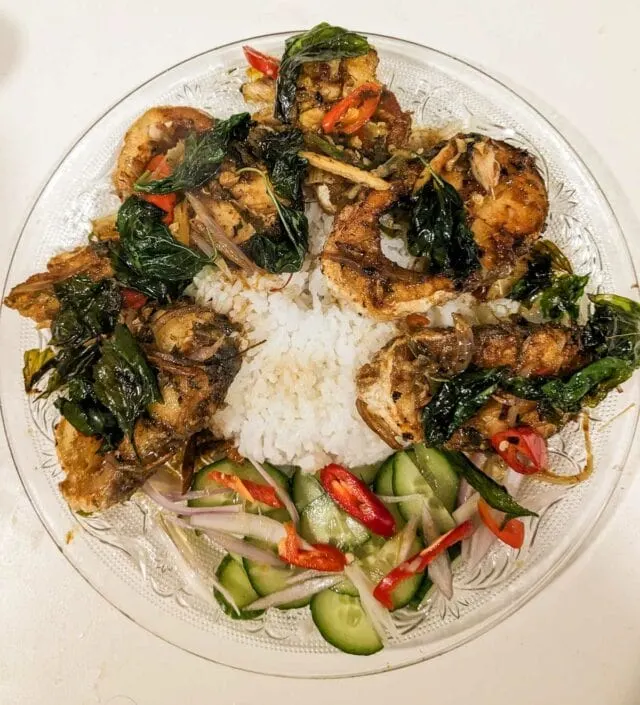
Pad Ped: A Thai Stir Fry Or A Lot More?
“Pad Ped”, or literally “spicy stir fry”, is such a simple name for a dish. It’s hard to imagine what the dish would look like and how it would taste, just thinking of the name.
It’s probably incredibly spicy, isn’t it? Stir-fried in a smoky wok like Pad Thai or Pad See Ew, right?
Well, “Pad Ped” is more than one dish and one flavor.
In another article, I have introduced you all to “Pad Ped Gai Pak Dtai“, a chicken dish from Southern Thailand and a staple of the Thai-Malay Muslims that live in the region. This version of Pad Ped is heavy on spices such as turmeric and shrimp paste. It sometimes resembles a curry more than a stir-fried dish.
However, as I traveled to other regions in Thailand, I happened to stumble upon many different dishes that were also called “Pad Ped” by the local community. Some dishes were spicier, others saltier, and some were actually quite sweet!
What’s going on?
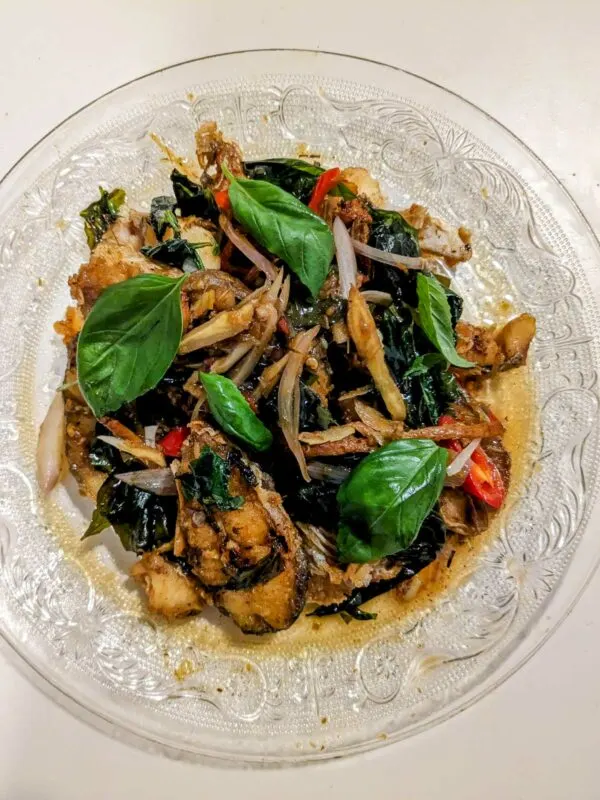
What is a Thai Pad Ped?
First, it is important to understand the meaning of the dish’s name.
While “Pad” means “stir fry” in Thai, a “Pad” dish isn’t necessarily stir-fried on high heat in a Chinese wok. Sometimes the word “pad” simply suggests that it is a “dry” dish (compared to curries, stews, or soups).
“Ped”, meaning “spicy”, indeed implies one of the dish’s flavor profiles.
However, it isn’t necessarily the main flavor in the dish. And, most importantly, spiciness is not only about chilies.
While chili peppers are indeed often added to Pad Ped, the main “spicy” flavor of the dish has traditionally derived from other ingredients that are native to the region, long before 1492.
Chili peppers were introduced to Thailand only in the 18th century. Before that, Thai cuisine relied on other plants to provide spiciness, such as finger root, galangal, and young peppercorns.
Pad Ped Pa Duk Tod – Central Thai Fried Catfish Pad Ped
The recipe that I’ll be sharing today is a Central Thai rendition of Pad Ped.
The dish is called “Pad Ped Pla Duk Tod”, or literally “Fried Catfish Pad Ped”. It is commonly served in Khao Gaeng stalls (shops that offer a wide array of curries, stir-fried dishes, and other local delicacies, served on top of white rice).
The dish is surprisingly not that spicy.
While taking a bite, one might first experience a burst of umami and salty flavors. Then, sweet and spicy savors gradually spread all around the mouth.
Not to forget the crispy texture of the dish and the juiciness of the catfish.
In traditional Khao Gaeng stalls, the dish isn’t usually prepared per order or per serving, but is often prepared in a large quantity early in the morning. Surprisingly, the catfish manages to maintain a crispy texture quite well as time goes by.
I actually prefer not to eat it right away. This way, I can let the catfish soak in some additional flavors and juices from the aromatics and seasoning of the dish.
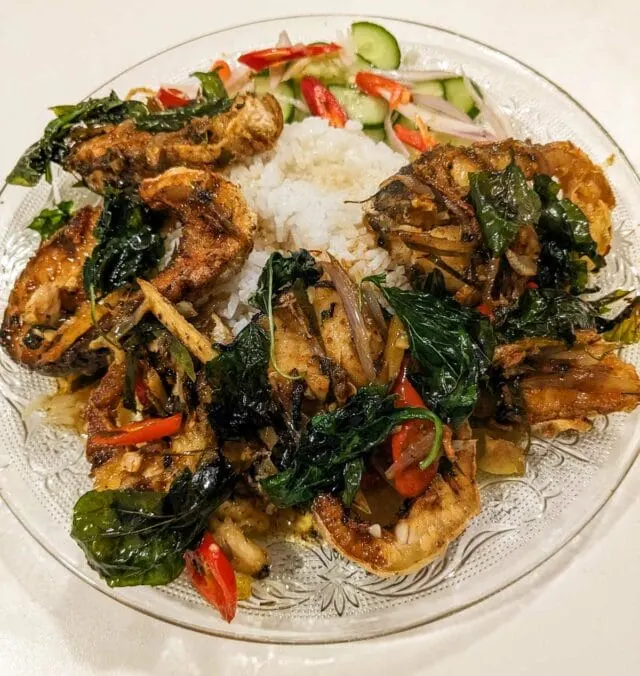
How to make this catfish stir-fry curry
Traditionally, the catfish for this dish is first fried.
Only then, it is stir-fried with aromatics, red curry paste, and seasonings such as oyster sauce (which suggests a Chinese influence on the dish). Usually, fried Thai holy basil (aka “Krapao”) is sprinkled on top of the dish.
The list of ingredients can vary per kitchen. Some cooks add a bit of coconut milk or evaporated milk, others leave it out. Aromatics such as galangal or fingerroot (both from the ginger family) are used interchangeably. In some versions, vegetables (Thai eggplants are quite popular) are added to the pan or wok while stir-frying.
As the dish is quite strong in flavor and crispy in texture, it is recommended to match it with soups or stews, as well as white rice, to balance the meal.
Nevertheless, if I am honest, this dish is so addictive that I often eat it on its own.
What is fingerroot?
Fingerroot (or finger root) ginger are both from the same botanical family and have a similar culinary role, creating a sort of sweet-and-spicy aroma. However, they don’t taste the same. Fingerroot is less sweet and has more of an “earthy” flavor.
In Thai cuisine, fingerroot (and galangal) have been traditionally used for centuries, while ginger made its later appearance due to Chinese influences. While Pad Ped reflects those Chinese influences, it also retains some older Thai traditions.
Fingerroot can also be found in China, but it is more of a medicinal ingredient, and not cooked with very often.
You can find fingerroot in your nearest Asian grocer. It looks like thin carrots clustered together, and does, unsurprisingly, resemble fingers.
Thai Catfish Curry (Pad Ped Pla Duk Tod)
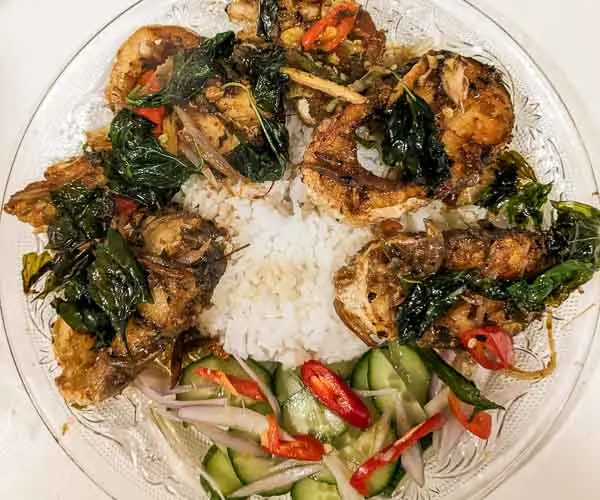
Pad Ped Pla Duk Tod is the name for a Central Thai catfish curry stir fry made with crispy fried catfish and a red curry paste.
Ingredients
- Vegetables oil, for frying
- 1.25 lb (600 g) bone-in catfish steaks *
- 4 "fingers" fingerroot (around 1.75 oz (50 g) total), cut into thin strips**
- 1 bunch holy basil leaves (around 3.5 oz (100 g)) ***
- 2 shallots, chopped
- 3 garlic, chopped
- 3 Tbsp fish sauce
- 3 Tbsp oyster sauce
- 3 Tbsp water
- 3 Tbsp sugar
- 2 Thai chilis, chopped
- 3 Tbsp vegetable oil
- 2 Tbsp red curry paste
- 8 Kaffir limes, cut into thin strips (with the stem removed)
- 1 spur chili, sliced
Instructions
- Wash the catfish steaks and dry them, using a kitchen towel. Cut any steaks that may be too big in half. (Consider the fact that Thai food is traditionally eaten without a knife.)
- Heat some frying oil in a large pan on medium heat. Fry the catfish until the meat is slightly golden on both sides and the skin is crispy. (Deep frying or shallow frying is up to you.)
- Take the catfish out of the pan and set aside.
- Fry the fingerroot strips for 2 minutes. Set aside.
- Fry the holy basil leaves for 30 seconds. Set aside.
- Grind the chopped shallots, garlic, and Thai chilis with a mortar and pestle, until a fine paste takes shape (a food processor can be used as well).
- To make the stir-fry sauce, combine the fish sauce, oyster sauce, water, and sugar in a mixing bowl and set aside.
- Heat 3 Tbsp of oil in a pan or a wok on medium heat. Add the ground paste from the mortar as well as the red curry paste and the Kaffir lime leaves.
- Add in the stir-fry sauce that you made earlier and bring it all to a boil.
- Add the fried catfish, fried fingerroot, and the spur chili into the pan and mix everything together. Stir fry for a minute or two.
- Sprinkle the fried holy basil leaves on top.
- Serve with white rice, fresh veggies, and an optional soup/stew. Enjoy!
Notes
*Traditionally, bone-in catfish steaks are used. However, it can be substituted for any boneless white fish (the fattier the better) of the same quantity.
** Fresh fingerroot (also known as Krachai or wild ginger) is quite difficult to find in some countries, even in Asian grocery stores. In that case, fingerroot can be substituted with galangal of the same amount. (If using dried galangal, be sure to rehydrate it first before weighing.)
*** Holy basil is a species of the basil plant that is native to Thailand and the region. It's considered to have a more peppery flavor than Italian basil. However, it can be substituted for Thai sweet basil or Italian basil.
Recommended Products
As an Amazon Associate and member of other affiliate programs, We earn from qualifying purchases.
Nutrition Information:
Yield:
4Serving Size:
1/4 of recipeAmount Per Serving: Calories: 766
If you liked this recipe, here are some similar dishes you may enjoy!




